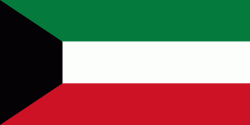Kuwaiti dinar
دك
The Kuwaiti dinar (دينار كويتي, code: KWD) is the currency of Kuwait. It is sub-divided into 1,000 fils.As of 2023, the Kuwaiti dinar is the currency with the highest value per base unit, with KD 1 equalling US$3.27, ahead of the Bahraini dinar with BD 1 equalling US$2.65.
The dinar was introduced in 1961 to replace the Gulf rupee, equal to the Indian rupee. It was initially equivalent to £1 stg. As the rupee was fixed at 1/6d, that resulted in a conversion rate of Rs.13 1⁄3 to KD 1.
When Iraq invaded Kuwait in 1990, the Iraqi dinar replaced the Kuwaiti dinar as the currency and large quantities of banknotes were stolen by the invading forces. After liberation, the Kuwaiti dinar was restored as the country's currency and a new banknote series was introduced, allowing the previous notes, including those stolen, to be demonetized.
Country
-
Kuwait
Kuwait ( الكويت ', or ), officially the State of Kuwait (دولة الكويت '), is a country in Western Asia. It is situated in the northern edge of Eastern Arabia at the tip of the Persian Gulf, bordering Iraq to the north and Saudi Arabia to the south. Kuwait also shares maritime borders with Iran. Kuwait has a coastal length of approximately 500 km. Most of the country's population reside in the urban agglomeration of the capital city Kuwait City. , Kuwait has a population of 4.45 million people of which 1.45 million are Kuwaiti citizens while the remaining 3.00 million are foreign nationals from over 100 countries.
Historically, most of present-day Kuwait was part of ancient Mesopotamia. Pre-oil Kuwait was a strategic trade port between Mesopotamia, Persia and India. Oil reserves were discovered in commercial quantities in 1938. In 1946, crude oil was exported for the first time. From 1946 to 1982, the country underwent large-scale modernization, largely based on income from oil production. In the 1980s, Kuwait experienced a period of geopolitical instability and an economic crisis following the stock market crash. In 1990, after oil production disputes with neighbouring Iraq, Kuwait was invaded, and later annexed into one of Iraq's governorates by Iraq under Saddam Hussein. The Iraqi occupation of Kuwait came to an end on February 26, 1991, after military intervention by a military coalition led by the United States and various other countries.
